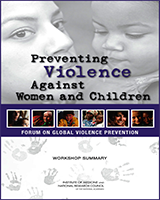NCBI Bookshelf. A service of the National Library of Medicine, National Institutes of Health.
Violence against women and children is a serious public health concern, with costs at multiple levels of society. Although violence is a threat to everyone, women and children are particularly susceptible to victimization because they often have fewer rights or lack appropriate means of protection. In some societies certain types of violence are deemed socially or legally acceptable, thereby contributing further to the risk to women and children. In the past decade research has documented the growing magnitude of such violence, but gaps in the data still remain. Victims of violence of any type fear stigmatization or societal condemnation and thus often hesitate to report crimes. The issue is compounded by the fact that for women and children the perpetrators are often people they know and because some countries lack laws or regulations protecting victims. Some of the data that have been collected suggest that rates of violence against women range from 15 to 71 percent in some countries and that rates of violence against children top 80 percent. These data demonstrate that violence poses a high burden on global health and that violence against women and children is common and universal.
Preventing Violence Against Women and Children focuses on these elements of the cycle as they relate to interrupting this transmission of violence. Intervention strategies include preventing violence before it starts as well as preventing recurrence, preventing adverse effects (such as trauma or the consequences of trauma), and preventing the spread of violence to the next generation or social level. Successful strategies consider the context of the violence, such as family, school, community, national, or regional settings, in order to determine the best programs.
Contents
- THE NATIONAL ACADEMIES
- PLANNING COMMITTEE ON PREVENTING VIOLENCE AGAINST WOMEN AND CHILDREN WORKSHOP
- FORUM ON GLOBAL VIOLENCE PREVENTION
- Reviewers
- 1. Introduction
- I. Workshop Overview
- II. Papers and Commentary from Workshop Speakers
- 6. Papers on Research in Preventing Violence Against Women and
Children
- PREVENTING INTIMATE PARTNER AND SEXUAL VIOLENCE AGAINST WOMEN: PRIMARY PREVENTION STRATEGIES
- INTERNATIONAL MEN AND GENDER EQUALITY SURVEY
- THE SCIENCE OF PREVENTION/INTERRUPTING THE CYCLE OF VIOLENCE
- TRAUMA-INFORMED CARE: A VALUES-BASED CONTEXT FOR PSYCHOSOCIAL EMPOWERMENT
- ENHANCING EMOTION REGULATION: A FRAMEWORK FOR PSYCHOLOGICAL EMPOWERMENT OF WOMEN AND CHILDREN EXPOSED TO VIOLENCE
- REFERENCES
- 7. Papers on Global Partnerships and Government Initiatives
- 8. Papers on Preventive Interventions
- THE IMAGE PROGRAM: SUMMARY
- INNOVATIVE PREVENTION INTERVENTIONS: ADDRESSING IPV AND POTENTIAL CHILD ABUSE AT PRENATAL CARE
- THE FOURTH R: A SCHOOL-BASED STRATEGY TO PREVENT ADOLESCENT DATING VIOLENCE
- THE COMMUNITY ADVOCACY PROJECT: AN EVIDENCE-BASED PSYCHOSOCIAL INTERVENTION FOR WOMEN WITH ABUSIVE PARTNERS
- USING A SYSTEMS-MODEL APPROACH TO IMPROVING IPV SERVICES IN A LARGE HEALTH-CARE ORGANIZATION
- REFERENCES
- 6. Papers on Research in Preventing Violence Against Women and
Children
- A Workshop Agenda
- B Speaker Biographical Sketches
- C Planning Committee Biographical Sketches
- D Forum Member Biographical Sketches
Rapporteur: Deepali M. Patel.
This study was supported by contracts between the National Academy of Sciences and the U.S. Department of Health and Human Services: Administration on Aging, Office of Women's Health; Anheuser-Busch InBev; Avon Foundation for Women; BD (Becton Dickinson, and Company); Catholic Health Initiatives; Centers for Disease Control and Prevention; Department of Education: Office of Safe and Drug-Free Schools; Department of Justice: National Institute of Justice; Fetzer Foundation; F. Felix Foundation; Foundation to Promote Open Society; Kaiser Permanente; National Institutes of Health: National Institute on Alcoholism and Alcohol Abuse, National Institute on Drug Abuse, Office of Research on Women's Health, John E. Fogarty International Center; Robert Wood Johnson Foundation; and the Substance Abuse and Mental Health Services Administration. Any opinions, findings, conclusions, or recommendations expressed in this publication are those of the author(s) and do not necessarily reflect the view of the organizations or agencies that provided support for this project.
Suggested citation:
IOM (Institute of Medicine). 2011. Preventing violence against women and children: Workshop summary. Washington, DC: The National Academies Press.
NOTICE: The project that is the subject of this report was approved by the Governing Board of the National Research Council, whose members are drawn from the councils of the National Academy of Sciences, the National Academy of Engineering, and the Institute of Medicine.
- NLM CatalogRelated NLM Catalog Entries
- Review Sexual violence against women: the scope of the problem.[Best Pract Res Clin Obstet Gyn...]Review Sexual violence against women: the scope of the problem.Dartnall E, Jewkes R. Best Pract Res Clin Obstet Gynaecol. 2013 Feb; 27(1):3-13. Epub 2012 Aug 29.
- [Implementing a pluridisciplinary network of intimate partner violence prevention].[Encephale. 2010][Implementing a pluridisciplinary network of intimate partner violence prevention].Bazex H, Thomas A, Combalbert N, Lignon S. Encephale. 2010 Feb; 36(1):62-8. Epub 2009 Mar 6.
- Review [Current status of the female condom in Africa].[Sante. 1997]Review [Current status of the female condom in Africa].Deniaud F. Sante. 1997 Nov-Dec; 7(6):405-15.
- Police and mental health professionals. Collaborative responses to the impact of violence on children and families.[Child Adolesc Psychiatr Clin N...]Police and mental health professionals. Collaborative responses to the impact of violence on children and families.Marans S, Berkowitz SJ, Cohen DJ. Child Adolesc Psychiatr Clin N Am. 1998 Jul; 7(3):635-51.
- Research suggests that one in two women, possibly more, experience violence in their lives.[Links (Oxford). 1999]Research suggests that one in two women, possibly more, experience violence in their lives.. Links (Oxford). 1999 Mar; :2.
- Preventing Violence Against Women and ChildrenPreventing Violence Against Women and Children
Your browsing activity is empty.
Activity recording is turned off.
See more...
